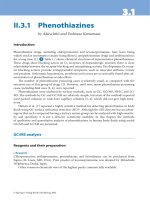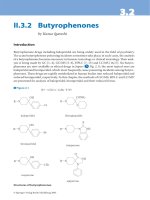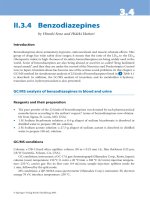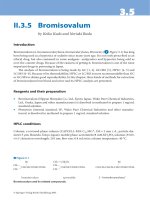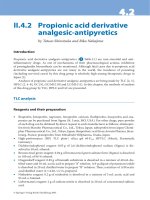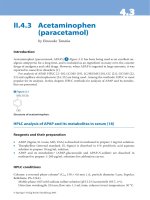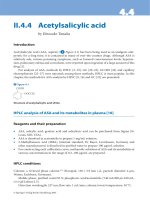Tài liệu Drugs and Poisons in Humans - A Handbook of Practical Analysis (Part 36) pdf
Bạn đang xem bản rút gọn của tài liệu. Xem và tải ngay bản đầy đủ của tài liệu tại đây (135.07 KB, 8 trang )
4.44.4
© Springer-Verlag Berlin Heidelberg 2005
II.4.4 Acetylsalicylic acid
by Einosuke Tanaka
Introduction
Acetylsalicylic acid ( ASA, aspirin) (> Figure 4.1) has been being used as an analgesic-anti-
pyretic for a long time; it is contained in many of over-the-counter drugs. Although ASA is
relatively safe, various poisoning symptoms, such as lowered consciousness levels, hypoten-
sion, pulmonary edema and convulsion, were reported upon ingestion of a large amount of this
drug [1].
For analysis of ASA, methods by HPLC [2–19], GC [20–23], GC/MS [24] and capillary
electrophoresis [25–27] were reported; among these methods, HPLC is most popular. In this
chapter, the methods for ASA analysis by HPLC [9, 16] and GC [23] are presented.
Structure of acetylsalicylic acid (ASA).
⊡ Figure 4.1
HPLC analysis of ASA and its metabolites in plasma [16]
Reagents and their preparation
• ASA, salicylic acid, gentisic acid and salicyluric acid can be purchased from Sigma (St.
Louis, MO, USA).
• ASA is dissolved in acetonitrile to prepare 1 mg/mL solution.
• 2-Methylbenzoic acid (MBA) (internal standard, IS; Bayer, Leverkusen, Germany and
other manufacturers) is dissolved in puri ed water to prepare 100 µg/mL solution.
• For constructing each calibration curve, methanolic solutions of ASA and its metabolites at
various concentrations in the range of 0.2–100 µg/mL are prepared.
HPLC conditions
Column: a reversed phase column
a, b
( Novapak, 150 × 3.9 mm i.d., particle diameter 4 µm,
Waters, Eschborn, Germany).
Mobile phase: puri ed water/85 % phosphoric acid/acetonitrile (740 mL:900 µL:180 mL,
v/v) (pH about 2.5).
Detection wavelength: 237 nm; ow rate: 1 mL/min; column (oven) temperature: 30 °C.
344 Acetylsalicylic acid
Procedure
i. A 200-µL volume of plasma
c
and 200 µL of MBA
d
solution are placed in a 1.5-mL volume
microtube, and mixed well for 1–2 s.
ii. e pH of the mixture is adjusted to about 2.7.
iii. A 400-µL volume of acetonitrile is added to the above mixture.
iv. It is vortex-mixed well at 4 °C for 15 min and centrifugal at 10,500 g for 1 min.
v. e supernatant fraction is transferred to another 1.5-mL volume microtube, followed by
addition of 100–120 mg NaCl
e
.
vi. e microtube is vortex-mixed and le at 4 °C for 10 min.
vii. It is centrifuged at 10,500 g for 1 min.
viii. A 10-µL volume of the supernatant fraction (acetonitrile layer) is injected into HPLC.
ix. For solutions of various concentrations of ASA and its metabolites, 200-µL aliquot each
was processed according to the above procedure for construction of calibration curves.
Assessment of the method
> Figure 4.2 shows an HPLC chromatogram for ASA and its metabolites extracted from
human plasma. By this method, ASA, salicylic acid, gentisic acid and salicyluric acid, which is
formed by glycine conjugation of salicylic acid, can be measured.
ASA and salicylic acid can be quantitated down to 100 ng/mL; the recoveries of ASA and
its metabolites were 107–122 %.
HPLC chromatogram for the authentic acetylsalicylic acid and its metabolites [16]. GA: gentisic
acid; SUA: salicyluric acid; ASA: acetylsalicylic acid; SA: salicylic acid; MBA: 2-methylbenzoic acid
(IS). Each compound was dissolved in 0.01 M hydrochloric acid solution to prepare 50 µg/mL
solution.
⊡ Figure 4.2
345
HPLC analysis of ASA and its metabolites in plasma,
tissues and urine [9]
Reagents and its preparation
ASA (Sigma) is dissolved in methanol; for calibration curves, solutions of ASA and its metabo-
lites at 0.2–10 µg/mL are prepared.
HPLC conditions
Column: a reversed phase column
a
( LiChrosorb RP-18, 150 × 4 mm i.d., particle diameter
5 µm).
Mobile phase
f
: methanol/puri ed water (60:40, v/v) (pH 3).
Detection wavelength: 280 nm; ow rate: 1.5 mL/min; column (oven) temperature: 45 °C.
Procedures
g
i. Plasma
i. A 200-µL volume of plasma
c
, 50 µL phosphoric acid and 600 µL ethyl acetate are placed in
a small centrifuge tube.
ii. e tube is voltex-mixed for 30 s and centrifuged at 600 g for 10 min.
iii. A 400-µL volume of the organic phase is transferred to a small glass vial, and evaporated to
dryness under a stream of air in an ice bath.
iv. e residue is dissolved in 200 µL of the mobile phase and injected into HPLC.
v. e solutions of ASA and its metabolites at various concentrations are processed according
to the above procedure.
ii. Organ tissues
i. A 500-mg aliquot of an organ tissue is minced in 2 mL of puri ed water and homogenized
with cooling with ice.
ii. It is centrifuged at 40,000 rpm for 30 s.
iii. e supernatant fraction is decanted to a test tube, and a 200 µL of it is subjected to the
procedure of the above i. plasma.
iii. Urine
i. Urine is diluted 10-fold with puri ed water.
ii. e diluted specimen is subjected to the procedure of the above i. plasma.
Assessment of the method
> Figure 4.3 shows an HPLC chromatogram for ASA and its metabolites extracted from
plasma of a rabbit, to which ASA had been administered intravenously 15 min before sampling
HPLC analysis of ASA and its metabolites in plasma, tissues and urine
346 Acetylsalicylic acid
of its blood. By this method, ASA and its two metabolites in human plasma, tissues and urine
can be analyzed. Quantitation limit of ASA and salicylic acid was about 500 ng/mL; the recov-
eries were 89–101 %.
GC analysis of ASA and its metabolite in serum [23]
Reagents and their preparation
• p-Hydroxybenzoic acid ethyl ester (IS, Sigma) is dissolved in puri ed water to prepare 15 µg/
mL solution.
• ASA is dissolved in methanol. For its calibration curve, ASA solutions at 10–250 µg/mL are
prepared.
HPLC chromatogram for ASA and its metabolites extracted from plasma of a rabbit, to which
50 mg/kg ASA had been administered intravenously 15 min before sampling of its blood [9].
SUA: salicyluric acid; ASA: acetylsalicylic acid; SA: salicylic acid.
⊡ Figure 4.3
347
GC conditions
Column
h
: a packed glass column, 2 % OV-225 Gas Chrom W (80–100 mesh, 1.2 m × 4 mm
i. d., obtainable from many manufacturers).
Temperatures: column 110 °C, injection port 250 °C, detector 300 °C; detector: FID; carrier
gas ( ow rate): nitrogen (60 mL/min); detector gas ( ow rate): air (100 mL/min) and hydrogen
(30 mL/min).
Procedure
i. A 100-µL volume of serum
c, i
, 2 mL of 1 M hydrochloric acid solution and 1 mL p-hy-
droxybenzoic acid ethyl ester (IS) solution are placed in a 10-mL volume glass centrifuge
tube with a ground-in stopper.
ii. A 5-mL volume of ethyl ether is added to the above mixture, shaken and centrifuged; this
procedure is repeated once.
iii. e combined organic phase (upper layer) is transferred to a 10–20 mL volume test tube.
iv. e phase is condensed to a small amount (about 1 mL) under a stream of nitrogen with
warming at 42–44 °C. e condensed extract is transferred to a 4-mL volume glass vial
with a silicone cap and evaporated to dryness under a stream of nitrogen.
v. e residue is mixed with 10 µL acetonitrile and 5 µL N,O-bis(trimethylsilyl)tri uoroacet-
amide (Pierce, Rockford, IL, USA) and heated at 60 °C for 10 min for silylation.
vi. A 2–3 µL aliquot of it is injected into GC.
vii. Solutions of ASA or salicylic acid at various concentrations are treated according to the
above procedure for constructing calibration curves.
Assessment of the method
> Figure 4.4 shows a gas chromatogram for ASA and its metabolite salicylic acid extracted
from human serum. Quantitative analysis of both compounds can be made in the range of
25–250 µg/mL.
Toxic and fatal concentrations [28, 29]
When 150–300 mg/kg of ASA is ingested orally, various poisoning symptoms, such as nausea,
vomiting and tinnitus, appear; when the dose exceeds 300 mg/kg, the symptoms become serious.
Dangerous oral doses of ASA for adults and infants are about 20 and 1.5 g, respectively. era-
peutic blood ASA concentrations: 20–100 µg/mL; toxic concentrations: 150–300 µg/mL; fatal
concentration: not lower than 500 µg/mL.
Toxic and fatal concentrations
